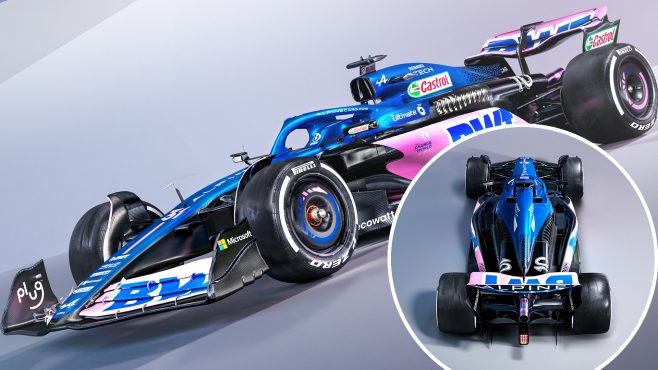Alpine was the last team to unveil its 2023 F1 car, the A523, and it’s a big change in philosophy from last year’s machine. Mark Hughes unpacks the changes to the midfield team’s new car as they aim to break into the top three.
Alpine’s A523 represents a very significant evolution from last year’s car, completely restyled and different from its new front spoiler and wider nose to its new pushrod rear suspension.
READ MORE: Alpine team boss Szafnauer sets clear target for 2023, shares update on ‘100-race plan’
Aggressive weight and aerodynamic targets have been met and the car is actually under the weight limit, allowing it to place ballast to suit the demands of individual circuits.
A new front wing hangs from a new, wider and flatter nose. The lower wing flap is now attached to the nose instead of hanging from it. Technical director Matt Harman says the new nose structure gives more freedom to make changes to the front wing elements, again giving more adjustability.
The new car (L) has a wider nose than last year’s (R), with the lower element of the wing attached to its tip rather than hanging from it. This, along with the improved anti-dive geometry of the front suspension, should help maintain more consistent aerodynamic balance through the different phases of a corner.
The front suspension retains the previous pushrod arrangement but the geometry has been changed to incorporate greater dive resistance under braking. That’s for the sake of the aerodynamic platform, which is more important than ever with this generation of ground-effect cars because the car’s attitude can determine how much of the incoming air goes through the bodywork and under the floor. If this ratio changes too much under braking and into the corner, the powerful floor means that if suddenly starved, the rear end can be unstable, only to return to a benign and less sensitive mid-corner balance when the car has been leveled. This is the opposite of what is desired, which is a stable rear end on entry, but good responsive cornering. This is a huge focus of effort for all teams under this rulebook.
The change in front suspension geometry is actually a good clue as to how the team has set out to achieve these aerodynamic gains. While last year’s car was generally well-balanced and more consistent than its midfield rivals, they were unable to match the sort of downforce levels achieved by the top teams. We can see on the A523 that there is a completely different layout of the entrances to the floor tunnels, implying a redesign of the entire floor area and how this vital part of the airflow is working.
The floor is the dominant part of the performance of this generation of cars.
READ MORE: 5 surprises, tech trends and bold calls from F1’s 2023 launch season
A523 (L) and A522 (R) showing a different suspension design: from pull bar (R) to push bar (L).
The layout of the radiator and the geometry of the sides it allows are largely determined by making the floor work as hard and consistently as possible. This also applies to front and rear suspension geometries.
As with almost all 2023 cars, there’s been a reallocation of the radiator area, and in this case Alpine has used it to achieve narrower sides, with a bulkier shoulder area above. The tops of the sidepods now feature a deep Ferrari-like trench, which channels airflow into the beam wing and prevents it from spilling over the sides of the cabin, keeping that flow high-energy and also helping remove the radiator outlet grills.
ANALYSIS: Can new A523 help Alpine’s all-French line-up close the gap on F1’s ‘big three’ this season?
The side designs of Alpine’s A523 (L) and A522 (R) were compared, showing how the reallocation of the radiator layout has meant a fatter shoulder area and reduced width of the sidepod, which now has a deeper channeled section. .
The very stiff floor and wide body of last year’s car kept the aero porpoise at bay, achieving a good level of control through the front and rear overhangs. With better control of the airfoil they feel they have achieved, and perhaps helped by this new nose and wing arrangement, they have been confident enough to move away from the wide sidepod.
VOTE: Choose your favorite F1 2023 car livery
The rear of the car has been completely reshaped, with a toggle switch for the suspension. Matt Harman says this has allowed for a simpler and lighter installation. The lower placement of the suspension rockers with a push rod design is probably partly responsible for how the body drops lower towards the rear axle than before.
Power unit reliability upgrades and a reduction in turbo inlet plenum temperature also promise increased performance.
More technical analysis of F1 2023 cars


